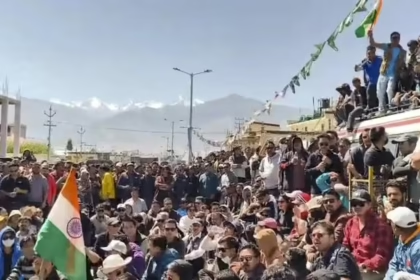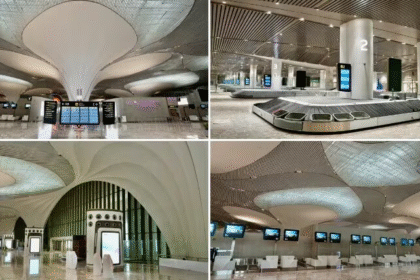When the Sea Rises – Mumbai’s Tryst with Nature’s Power
A City on the Brink of Water
Mumbai is no stranger to water. Built on reclaimed land and surrounded by the Arabian Sea, the city breathes with the tide. Yet, each monsoon brings with it a tense uncertainty—how much water can the city absorb before it begins to drown in its own geography?
On June 24, 2025, the Indian Meteorological Department (IMD) issued its most urgent warning of the season. A “highest tide alert” was sounded for the Mumbai coastline, predicting tides reaching up to 4.5 metres over the next three days. In a city already battling intense rainfall and waterlogging, this was not just a weather update—it was a red flag fluttering over civic preparedness, climate resilience, and human vulnerability.
Understanding the IMD Alert – What Does 4.5 Metres Really Mean?
To the untrained eye, “4.5-metre high tide” may sound like just another number. But for Mumbai, where the margin between road and sea is sometimes a matter of inches, this number can decide whether a neighborhood stays dry or gets submerged.
The IMD classifies tide levels based on astronomical cycles—spring tides, neap tides, and storm surges. A 4.5-metre tide is considered extreme, especially when it aligns with:
- Heavy rainfall, which limits drainage outflow
- High lunar activity, such as a full moon
- Coastal wind patterns, pushing sea water further inland
For three consecutive days, all these elements are forecast to coincide, amplifying the tide’s impact.

The Areas Most at Risk – From Colaba to Kurla
Mumbai’s coastal vulnerability is not uniform. Certain areas have historically been flood hotspots, and this alert places them squarely in danger once again:
- Colaba & Marine Drive: Directly exposed to tidal surges; luxury real estate with poor elevation.
- Worli Sea Face & Haji Ali: Areas where waves routinely crash onto roads during high tide.
- Kurla & Sion: Low-lying inland areas where rainwater backs up when the tide blocks stormwater drains.
- Dharavi & Mahim: Densely populated informal settlements with minimal protection from overflow.
- Andheri Subway & Milan Subway: Known for turning into water traps during simultaneous rainfall and tide surge.
For residents here, a high tide alert isn’t just meteorological—it’s personal. It means moving valuables to higher shelves, rolling up carpets, checking sump pumps, and charging phones in anticipation of power cuts.
Mumbai’s Civic Response – BMC on High Alert
The Brihanmumbai Municipal Corporation (BMC), Mumbai’s governing civic body, responded swiftly to the IMD’s announcement:
- Deployed extra water pumps in chronic flood zones.
- Dispatched dewatering teams to key railway underpasses.
- Issued SMS alerts and push notifications through MyBMC app.
- Ordered temporary closure of flood-prone subways during peak tide windows.
- Activated coordination with BEST, Mumbai Police, and Disaster Management Units.
The BMC has also requested Mumbaikars to avoid non-essential travel, especially during the forecasted high tide hours between 11:30 AM and 2:30 PM.
However, critics argue that mere alert mechanisms are no substitute for structural change. A coastal city facing repeated tidal threats needs a long-term flood mitigation blueprint, not just day-to-day firefighting.
A City Shaped by the Sea – History of Mumbai and Tides
Mumbai’s relationship with water is ancient and paradoxical. The city was once an archipelago of seven islands, slowly joined together by land reclamation under British rule. But the sea, which receded then, has never stopped trying to return.
Over the years:
- 2005 Floods brought 944 mm of rainfall in a single day, paralysing the city for 3 days.
- 2014–2019 saw yearly tide alerts breaching the 4.4 metre mark.
- In 2021, a 4.87-metre tide combined with Cyclone Tauktae to flood major transport links.
Each incident serves as a reminder that coastal urbanization without climate foresight is courting catastrophe.
The Human Side of the Tide – Daily Lives Disrupted
Beyond statistics and alerts, high tides reshape human lives in quiet but devastating ways:
- Fisherfolk in Colaba and Worli must pull their boats ashore, sacrificing income.
- Daily wage workers risk losing earnings if trains are halted or buses rerouted.
- Patients in low-floor clinics and hospitals face mobility challenges, especially if water reaches street level.
- School children, particularly in municipal schools, may be advised to stay home—disrupting already fragile academic calendars post-COVID.
- Commuters and gig workers, especially food delivery agents and cab drivers, navigate flooded roads to keep the city’s engine running.
For every tide that enters Mumbai, it also exposes the invisible inequities—who can escape it, and who must bear it.
Tide as a Test of Resilience and Policy
The IMD’s alert is not just a test of Mumbai’s flood-control infrastructure, but of its governance, planning, and social justice frameworks. Will the roads flood again? Will slums see stagnant water and disease? Will the local trains stop? Will citizens be stranded without timely help?
These are no longer unpredictable questions. They’re part of a pattern—one that grows clearer with every monsoon season.
As the sea rises, so must Mumbai’s capacity to plan, prevent, and protect—or it risks becoming a city constantly surviving its next submergence.
Also Read : 1 Shocking Rail Disruption in Telangana: Woman Drives Car on Tracks, Halts 5 Train Services







